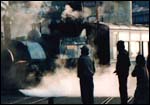


|
|
 |
| HOME | TRAVEL | TRAVELOG | ||

Last Train to Darjeeling ... a hill station of the Raj Jaideep and Suniti Mukerji
It takes more than an hour to prepare the ageing, century-old steam engine for its journey. If you reach the station early, you will find the fireman shovelling coal into the firebox to build up a head of steam while the engine driver turns the shiny brass valves. As the station master rings the platform bell, the Darjeeling Passenger 1 Dn hauled by one of the few remaining steam engines in India pulls away with an asthmatic whistle, clouds of steam and a shower of coal cinders. The first train of the day, the Darjeeling Passenger 3 Dn, has left at 7.15. The train connects villages spread along the mountain slopes and provides the cheapest means of moving locally grown produce from the villages to the bigger towns of Darjeeling and Siliguri. Plans to change the two feet wide railway gauge -- possibly the narrowest in the world -- to a wider track have been scrapped time and again due to the enormous cost of cutting the steep slopes. I stand near the open door with my feet carefully planted between baskets of fresh spinach and sacks of cabbages hoping to catch both the breeze and the view. It's 110 kms from the steamy plains of north Bengal to Darjeeling, 7,000 feet up in the eastern Himalayas. And it takes all of nine hours to reach Darjeeling at a speed not much faster than walking. As the age of steam locomotives comes to a close in India, the Darjeeling Hill Railways's fan club grows bigger by the day with active chapters as far away as Wales, the US and Canada. In the small town of Tindharia (Three Streams), not far from Jalpaiguri, is the almost pre-industrial workshop where the Darjeeling trains, with names like Mountaineer, Green Hills and Meghdoot, are repaired. All having been built between 1892 and 1925 in some long forgotten Glasgow factory. The place is layered with coal dust. The 'technicians', in grimy overalls, know they work in what could easily be a living museum; closer in age to an 1890s engine workshop. It is a fascinating place where you could easily spend a day immersed in steam train nostalgia. Darjeeling and the dozens of villages that dot the fertile slopes around it did not exist 165 years ago. By skullduggery and political manoeuvre, an official of the East India Company acquired the Darjeeling hill from the Chogyal of Sikkim in 1835.
To return to our journey, the three bright blue carriages attached to the ageing Mountaineer overflow with eager Bengali tourists. As we sway and wheeze past Tindharia and Sevoke, the flat rice paddy gives way to the first tea plantations. At this low altitude, I am told that only the strong Assam tea varieties grow. The train passes within feet of the houses that line the tracks. I wince as I see young children on the train stick their arms out and playfully touch residents as they go about their chores. Unlike in most parts of India, the mainly Nepali speaking people, who inhabit the lower and middle slopes, have a strong tradition of growing (and using) flowers. Each of the tiny, tin-roofed dwellings, that precariously sit between the railway track and steep slopes, have neat rows of old Dalda oil, Amul milk powder and Nestle baby cereal dabbas Plump babies, with neatly slicked back hair, loll in the morning sun. Groups of carefully scrubbed and groomed school children wave to us as we rattle past. Village women with crisply ironed, brilliantly coloured saris walk in groups to the vegetable haats (markets). There is a spirit of optimism, briskness and self worth.
It is noticeably cooler and less humid; we have, after all, climbed about 4,500 feet from the plains. The tourists from Bengal immediately don enough woollen jackets, caps, socks and gloves to make me wonder if we are about to enter the Darjeeling branch of the Siberian Arctic. Photographs by Jaideep Mukerji and Kevin J Vogeley
|
|
|
Continued
|
|
|
|
|
|
HOME |
NEWS |
BUSINESS |
CRICKET |
MOVIES |
CHAT
INFOTECH | TRAVEL | LIFE/STYLE | FREEDOM | FEEDBACK |
|